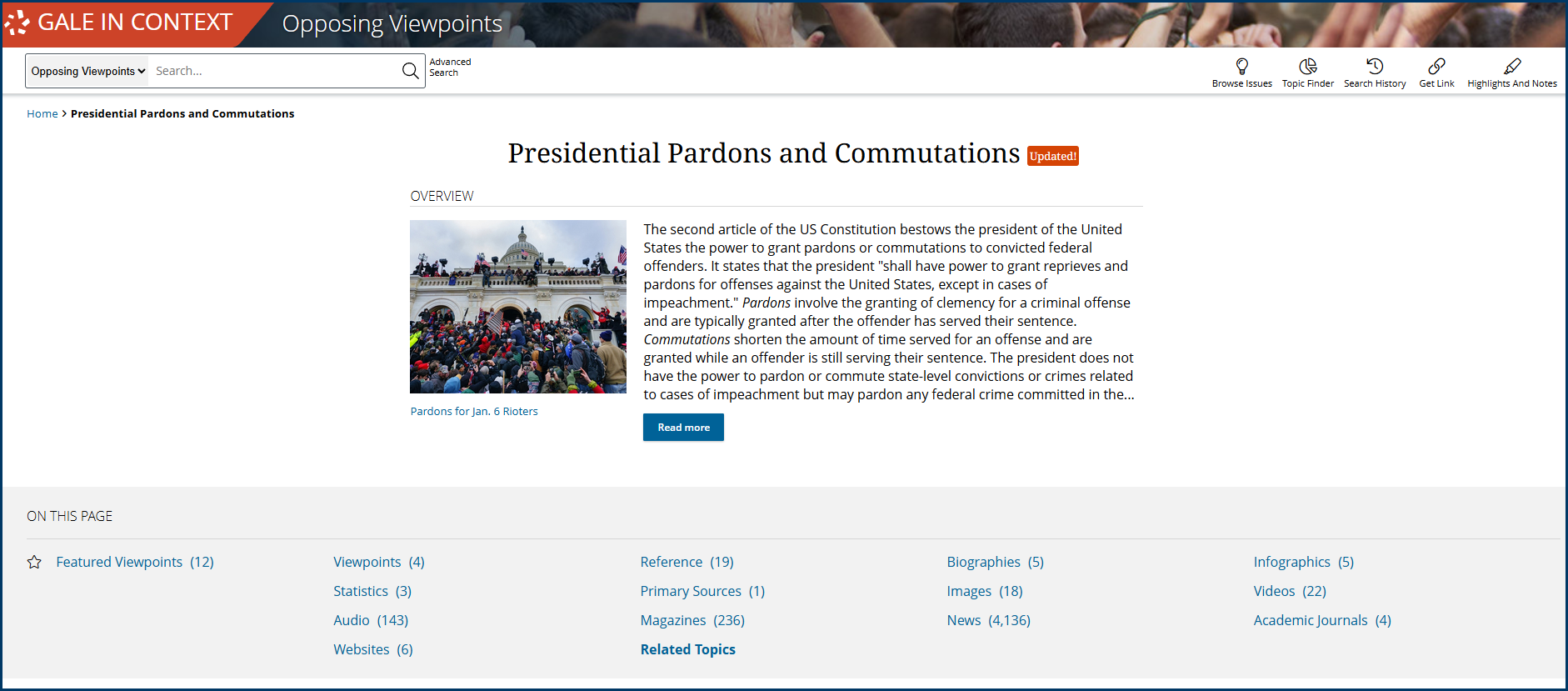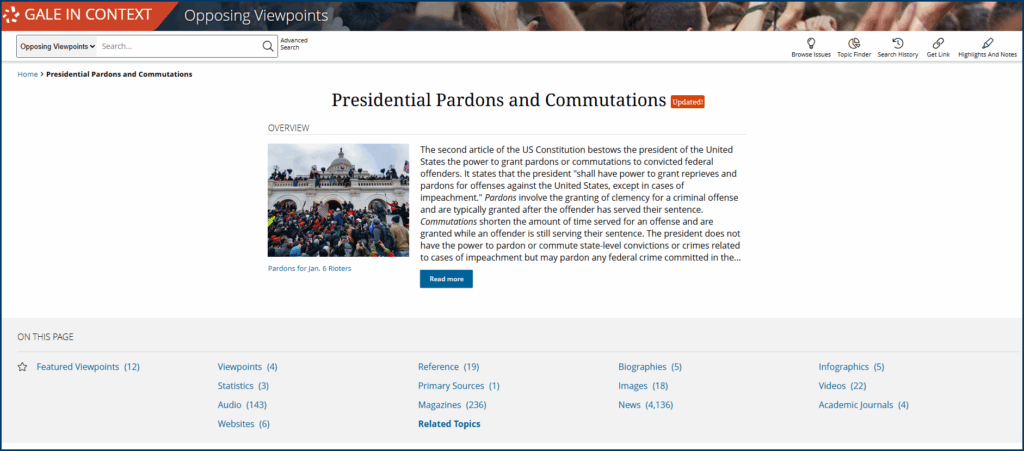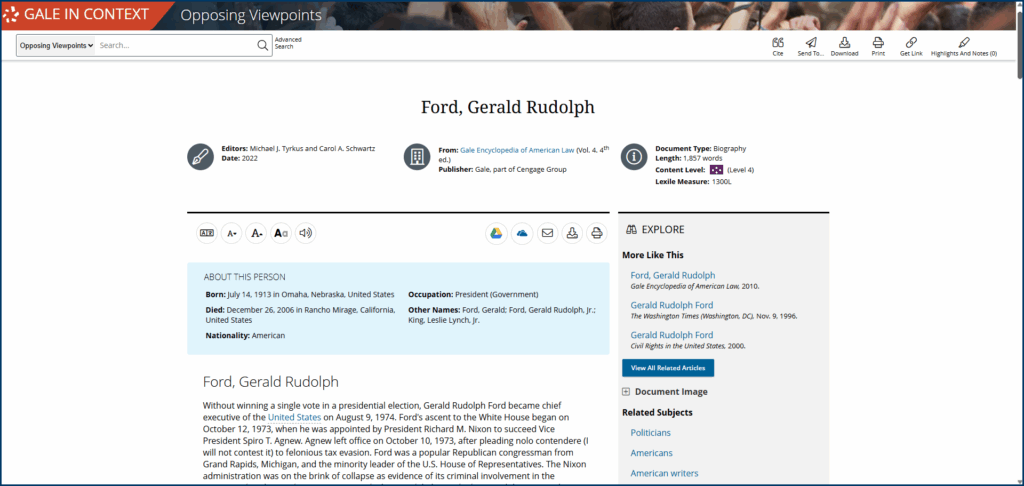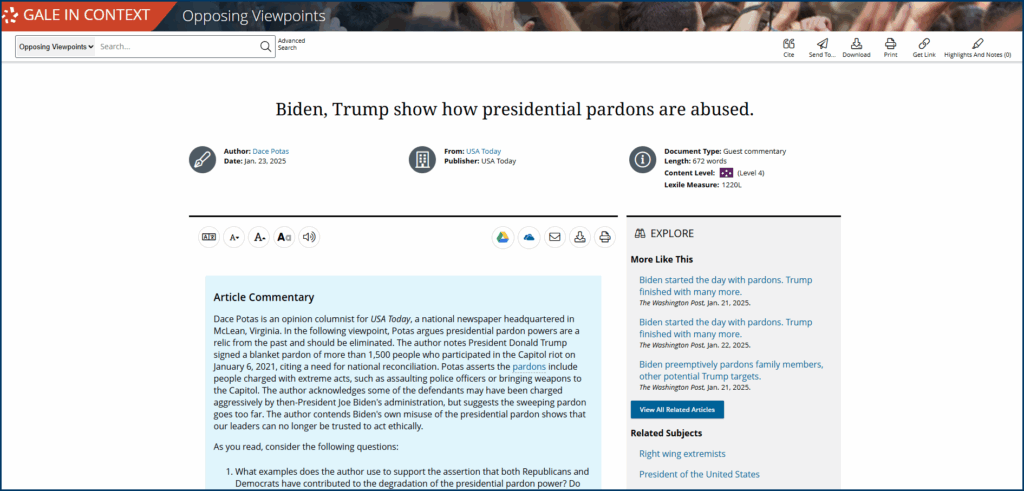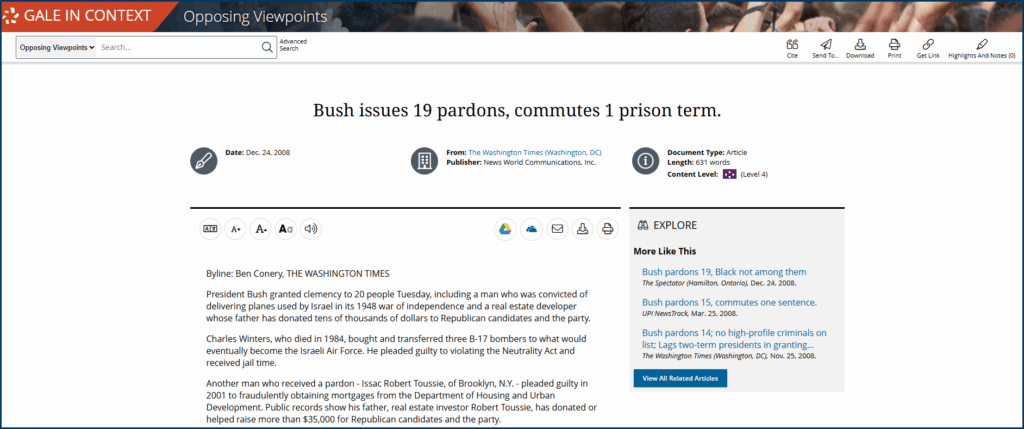Each November, a curious ritual plays out on the White House lawn. Cameras flash as the president spares a turkey from winding up as Thanksgiving dinner in an act of clemency that draws chuckles and smiles rather than legal scrutiny. While the annual turkey pardon is a lighthearted tradition, it echoes one of the most powerful—and controversial—tools in the executive arsenal: the presidential pardon.
Presidential pardons bypass the usual checks of the justice system, placing extraordinary legal authority in the hands of a single individual. Its use has often stirred debate, particularly when it appears to serve personal or political interests rather than principles of justice or mercy.
The presidential pardons and commutations topic page in Gale In Context: Opposing Viewpoints provides students with a structured way to engage with the full spectrum of arguments surrounding this power. Invite your classroom to examine how the same constitutional tool can be defended as an act of conscience or condemned as an abuse of privilege.
Constitutional Origins and Historical Use of the Presidential Pardon
The presidential pardon traces its authority to Article II, Section 2 of the US Constitution, which grants the president power to “grant Reprieves and Pardons for Offences against the United States, except in Cases of Impeachment.” Drawing on the English monarchy’s tradition of clemency, the founders viewed this power as a tool for tempering the rigidity of the law when circumstances demanded flexibility.
Alexander Hamilton, writing in “Federalist No. 74,” defended the pardon as a necessary fail-safe. In moments of rebellion or national division, he argued, a single authoritative voice might restore peace more effectively than a divided Congress.
One of the earliest examples occurred in 1795 when George Washington pardoned participants in the Whiskey Rebellion to ease tensions following a violent tax protest. The federal government had already deployed troops to suppress the uprising, demonstrating its capacity to enforce the law. But by offering pardons once the conflict subsided, Washington distinguished the new republic from the monarchy it had rejected. Clemency was not a tool to “[raise] money and [raise] armies,” but a deliberate act aimed at reconciliation. It reinforced federal authority while signaling that punishment was not the only solution to political dissent.
Abraham Lincoln
During the Civil War, Lincoln frequently granted pardons to deserters and Confederate sympathizers, especially young soldiers or those coerced into service. He viewed the pardon not just as a legal instrument but as a tool for reuniting the country. In one notable case, he spared a 16-year-old Union soldier who had fallen asleep at his post, choosing compassion over the standard penalty of execution.
Franklin D. Roosevelt
FDR issued more than 3,600 pardons and commutations during his presidency, most of which were handled through standard Department of Justice channels. His administration demonstrated how the pardon power could function as a regular part of the justice system rather than a headline-generating exception.
Gerald Ford
On September 8, 1974, just one month after taking office, Gerald R. Ford granted former President Richard Nixon a “full, free, and absolute pardon” for any crimes he may have committed while in office. Ford argued the country needed to move on from Watergate, but the decision was deeply unpopular and is widely believed to have damaged his chances in the 1976 election.
Jimmy Carter
In 1977, Carter issued a blanket pardon to hundreds of thousands of men who had evaded the draft during the Vietnam War. While not universally praised, the move was primarily seen as a step toward reconciliation after a divisive era in American history.
Critical Thinking Questions
- How did early leaders use the pardon power to promote political stability? How might that differ from how we view it today?
- In a system built on the idea of shared powers, what are the benefits and risks of giving one person final authority over legal outcomes?
Research Activity
Using Gale In Context: Opposing Viewpoints, investigate early examples of presidential pardons—such as those issued by Thomas Jefferson, Franklin Pierce, and Andrew Johnson.
For each example, consider the broader political or social climate of the time. How did each pardon reflect or contradict the administration’s stated priorities? Were these decisions seen as stabilizing? Divisive?
Legal Structure: Oversight and Calls for Reform
The presidential pardon is one of the few constitutional powers that remains largely unchecked. In Schick v. Reed (1974), the Supreme Court affirmed that “Congress can neither limit the effect of [the president’s] pardon, nor exclude from its exercise any class of offenders. The benign prerogative of mercy reposed in [the president] cannot be fettered by any legislative restrictions.”
That independence extends even to internal processes. The Department of Justice’s Office of the Pardon Attorney serves in a strictly advisory role. While presidents may choose to consult it, they are under no obligation to do so and can disregard its recommendations entirely. In practice, this means that the pardon operates with minimal procedural oversight, even from within the executive branch.
That freedom can serve noble purposes, such as correcting judicial errors and showing mercy. Still, it opens the door to criticism and calls for repeal, especially when clemency appears to benefit political allies or evade public scrutiny.
The Lame Duck Problem
Presidents often issue their most contentious pardons in the final days of their term, when they are no longer subject to electoral consequences. During this lame-duck period, there’s little political cost to acting in a way that might be perceived as controversial. Some use the pardon to resolve unfinished agendas; others extend clemency to allies whose cases might not withstand public scrutiny.
What further complicates the issue is that a presidential pardon is final. No court can overturn it, and no branch can compel justification. This structural independence gives presidents extraordinary latitude. The lack of review is intentional, but it also means that even the most debated decisions face no formal challenge, reinforcing a version of executive power that operates outside the reach of democratic oversight.
Precedent and Public Trust
Every pardon sends a message, whether intended or not. When presidents use this power in ways perceived as self-serving, they risk setting a precedent that future leaders may follow. Because the Constitution imposes no formal limits, precedent fills the gap, influencing what appears acceptable when using executive clemency. If controversial pardons go unchallenged, they don’t just reflect one president’s judgment, but expand the potential boundaries of how future presidents may exercise that power.
Selective Mercy
Clemency offers presidents a way to mitigate the impact of the justice system—to intervene in cases of excessive punishment, wrongful conviction, or extraordinary circumstances that warrant a second chance. But in practice, access to that mercy remains limited. Thousands of people with nonviolent convictions or compelling rehabilitation records file petitions that are never granted or even reviewed.
President Biden took steps toward broader access in the face of changing legal norms by granting pardons for simple marijuana possession. However, his decision to pardon his son, Hunter Biden, drew criticism. When mercy reaches those with proximity to power, it throws into sharper relief the many who are still waiting—no less deserving, just less connected.
Critical Thinking Questions
- Should the power of pardon be treated differently from other executive powers that are checked by Congress or the courts? Why might the framers have designed it this way? Does that logic still hold today?
- What consequences—intended or unintended—might result from limiting how and when clemency can be granted?
- Proposals to reform the pardon system often call for transparency or independent review. How could those changes be implemented without undermining the flexibility that some presidents have used to address politically sensitive or morally urgent cases?
Symbolic and Speculative Pardons: Expanding the Boundaries of Clemency
Presidential pardons were once used mainly to reduce sentences or correct legal injustices. Today, they serve additional functions.
Posthumous Pardons
Posthumous pardons have become increasingly common in recent decades, often aimed at correcting historical injustices or revising the legacy of specific figures. Because these acts carry no legal effect on the deceased, they are usually framed as a symbolic acknowledgment of a previous miscarriage of justice.
In 1999, Bill Clinton posthumously pardoned Henry O. Flipper, the first black graduate of the US Military Academy at West Point. Flipper had been court-martialed in 1881 on contested embezzlement charges, widely believed to have been racially motivated.
One of George W. Bush’s 200 pardons included that of Charles Winters, an American businessman convicted in 1948 for helping supply aircraft to Jewish forces during the formation of the state of Israel. Winters was not seeking clemency—he had died decades earlier—but the pardon was requested by his family and supported by lawmakers as a way to recognize his contribution to what they considered a just cause.
Preemptive Pardons
Although rarely used, preemptive pardons—granted before any charges are filed—have become a more visible part of modern political discourse. The most famous example remains Gerald Ford’s 1974 pardon of Richard Nixon, issued before Nixon had been formally charged in connection with the Watergate scandal.
In the final days of his presidency, Joe Biden issued preemptive pardons to several prominent figures, including Representative Liz Cheney and Dr. Anthony Fauci. Both had drawn the ire of President Trump—Cheney for her role investigating the January 6 US Capitol attack, and Fauci for his leadership during the COVID-19 pandemic. Their inclusion in Biden’s pardons was widely seen as protection against potential political retaliation by the Trump administration.
Critical Thinking Questions
- Should the executive branch have the power to reinterpret historical injustices through symbolic acts of clemency? What does this suggest about how historical accountability is constructed—and who gets to construct it?
- How do preemptive pardons affect the principles of justice in a democracy? Consider how they relate to specific concepts such as the right to a fair trial, protection against political persecution, the balance of powers among branches of government, and the idea that all individuals should be treated equally under the law.
Presidential pardons are legally straightforward, but carry deep political and ethical questions, making it a powerful topic to engage students in critical thinking and discussions about how power works in government.
Gale In Context: Opposing Viewpoints provides educators with primary sources, editorials, and expert commentary that can be easily integrated into lesson plans to spark debate and help students explore the complexities of executive power.
To learn more about Opposing Viewpoints and request a trial, reach out to your Gale sales representative.

